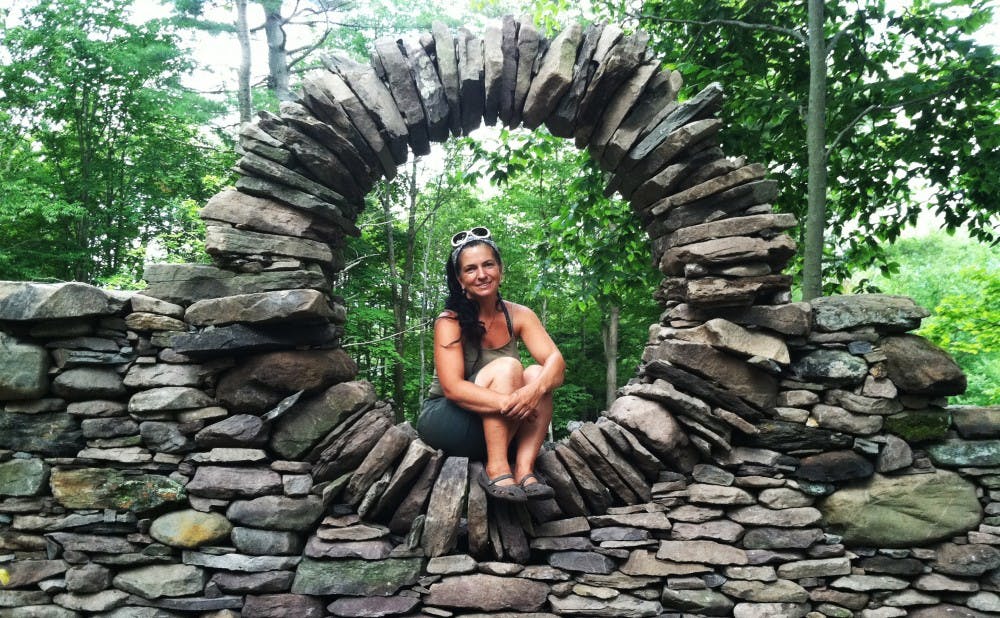Work began this week on a unique addition to Duke’s landscape. The in-progress Environment Hall, located behind the LSRC, will feature a stonewall sculpture as an integrated part of the landscaping in front of the building. Almost two years ago, the Dean of the Nicholas School for the Environment, Bill Chameides, approached stonemason Thea Alvin about creating one of her stone sculpture-landscapes for the planned Environment Hall building.
“We wanted [the landscaping] to be unique, because the Environment Hall building is unique and moves the campus in a different direction,” Chameides said.
Environment Hall is not an expansion for the Nicholas School, but rather will allow the faculty to be closer together. The new building is LEED Platinum certified—the highest level of green building certification—and is designed to have more public space to foster “co-mingling,” Chameides said. The building will be finished towards the end of March and the opening will be in early April. It also will include an environmental art gallery and a green roof where students will grow sustainable vegetables and herbs.
Chameides felt that Alvin’s work was in agreement with the goals of the Nicholas School to view humanity and the environment as an integrated whole.
“At least for humanity, humanity is an important part of the natural system. When we do alter that system, we need to it in a way that is in harmony and not destructive,” Chameides said.
Thea Alvin is a stonemason and landscape artist based in a small, rural Vermont town. She designed the landscape sculpture, entitled “In Good Time,” and will be constructing the piece with assistance from her partner Michael Clookey. Alvin primarily works without mortar, utilizing centuries-old dry masonry techniques. She described an aspect of her work as being about the dance that results from the contrast between herself, as a small woman, and a heavy material. However, Alvin does not see stone simply as a weighty or unmanageable medium.
“It’s a living rock, a natural material…an almost liquid state of being,” Alvin said, "I love for stone to look fluid, for the finished sculpture to look like it might be a pencil sketch."
Alvin draws on a foundation of masonry, building construction, architecture and interior design to complete her work. She also specializes in historic restoration and teaches a range of stone masonry classes at Yestermorrow Design/Build School in Warren, Vermont.
“The rules don’t change—just the application,” Alvin said of switching between landscape art and 15th-century building techniques.
Alvin’s work walks the boundary between spatial design and sculptural art. She doesn’t simply create objects that live in a gallery; she creates experiences, solid spaces and ephemeral moments. She has created pieces in the bottom of rivers during the dry season, leaving people to watch as the seasons progress and water rises, eventually obscuring the stones from view, and perhaps even moving them out of position.
“When it breaks back down, it’s just as beautiful,” Alvin said of work that changes.
The addition of “In Good Time” marks a shift for the university towards increased interdisciplinarity, but also more awareness of and connection to the world around us. Chameides supports collaborations between the arts and the environment, because of artists’ abilities to move past the tendency to see nature as the “other,” rather bringing us into a “face-to-face experience with nature.”
“In Good Time” will be built from stone sourced from the Duke quarry—the same quarry that provided much of the stone on campus, lending the sculpture the iconic color palette of the university.
“[It’s] creating a sense of place,” Alvin said of the elements in the design process.
The piece will rise to 10 feet in height, curving along its length to reach a total of 160 feet. At one point it will appear to dive underground. The highlight of the piece will be the keyhole arch in the center, “a point of entry,” Chameides said.
“It says you are now moving from a campus into a different kind of space,” Chameides said.
Alvin will be at Duke for three weeks, working on the piece as long as weather permits. She also will be giving a lecture and arch-building workshop, both sponsored by the Nicholas School of the Environment and the Sarah P. Duke Gardens.
By the time Environment Hall opens in the late spring, “In Good Time” will be surrounded by chestnut and beech trees, providing a place for students to sit, eat and rest. And, Alvin and Chameides hope that students will utilize the outdoor space. The stone structure was specifically designed to be the perfect height for sitting at certain points. With this type of work, the only way to appreciate it is to live in it—not just to look at it.
“[The art is] the beauty of being in it.” Alvin said. “It’s the interaction of me and the natural.”
Thea Alvin will give her lecture, "The Art of Stone," on Wed., February 19 at 6 p.m. in Room A247 of the LSRC. Admission is free but will be capped at 40. The arch-building workshop will be Sun., February 23 at 2 p.m. in the Charlotte Brody Discovery Gardens. Admission is free but will be capped at 10. To enroll in either event, call 919-668-1707 or email gardenseducation@duke.edu. For more information, visit the Nicholas School's website.
Get The Chronicle straight to your inbox
Signup for our weekly newsletter. Cancel at any time.

